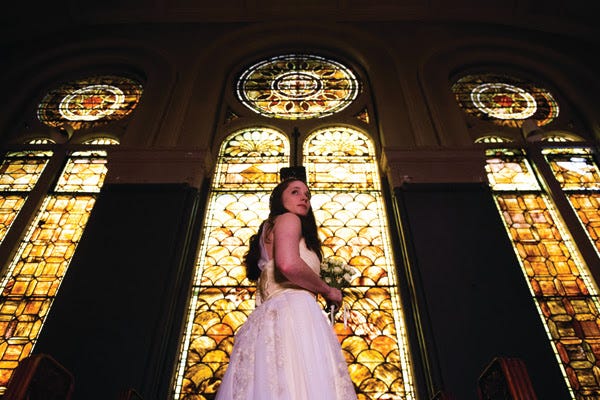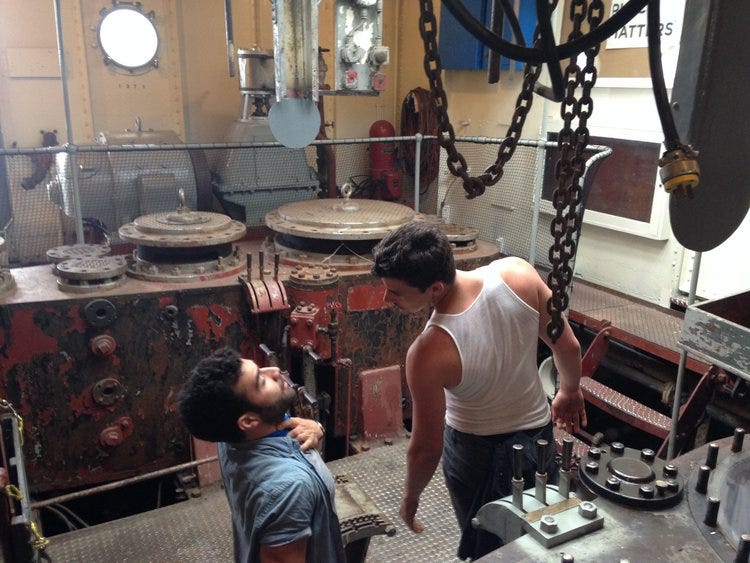
On their approach to creating work that combines movement, text, and live music
Linked Dance Theatre is a New York City-based company combining site-specific dance and theatre, while often performing in unusual or public settings with live musical accompaniment. They’ve staged their productions in locations ranging from an old 1930s steamboat to deep within Central Park to the crowded sidewalks of Manhattan’s East Village. And now, they are about to open their biggest production to date: Beloved/Departed, a retelling of the Greek myth of Orpheus and Eurydice in a historic church on the Upper West Side of Manhattan. Audiences are invited by Aphrodite, Goddess of Love, to attend this celestial wedding, where they will celebrate with other guests and divine creatures, and learn whether love is truly enough.
We caught up with co-artistic director Jordan Chlapecka in the midst of the wedding planning and asked him our Immersive 5 (with additional contributions by Kendra Slack).
This interview has been edited lightly for clarity.
No Proscenium (NP): What does “immersive” mean to you?
Jordan Chlapecka (JC): “Immersive,” to me, is somewhat of a contested term. Like the word “interesting,” or “performance,” “immersive” lives in this transient space that sometimes requires air quotes to capture all of its possible meanings, even if just for a brief moment.
Immersive is like flow: being in and of a moment, like having a world to yourself but not necessarily alone. I can be immersed in a task, or a thought, or a show, however that doesn’t make any of those things immersive, but it doesn’t make them not (or not not) immersive.
The meaning of “immersive” is constantly created and destroyed by those who use it, including myself, and that’s why I love it, and its many meanings.
NP: Why (or why don’t) you think of your work as immersive?
JC: We have some rules we abide by like narrative audience purpose, and environmental requirements, but in the end, I think it’s the human-ness that makes our work truly immersive. Our audiences are invited to create effect with our performances — to witness voyeuristically, to save, or to participate in a ritual of some sort, which are all all very human actions.
We’ve had mermaids, witches, and bearded ladies in shows, but at the end of the day, we ask ourselves: does it speak to something larger and can someone connect to it directly, humanly — is the veil lifted?

NP: What was the moment where you knew that this kind of work was for you?
Get Kathryn Yu’s stories in your inbox
Join Medium for free to get updates from this writer.
SubscribeSubscribe
JC: It wasn’t a single moment, but a series of moments. First I met Kendra Slack. (I think that story might be on our NoPro podcast interview.) Kendra has had a rather large impact on my artistry. I had also seen Sleep No More a few times, which was inspiring. Combine that with my weird training of performance practices and theory at NYU.… (Performance Studies made me question everything and question what was possible.)
I kept having these weird thoughts about what if Sleep No More was more — more than just a bunch of dance tracks, more than one warehouse location…more real. I approached Kendra about a show, that was part dance-performance art in public and part relationship-narrative. I had a vision but no clue how to focus it into a show. She was that focus and helped me make it happen. The result was the earlier version of Like Real People Do. Which was by no means perfect, but I liked the bendy, flexible space we pulled people into. It caused the audience to question a lot of things about the characters and themselves. Having Kendra by my side made me focus “Jordan,” fresh out of grad-school, who was doing museum performances, into telling a succinct narrative. I liked the challenge and needed the help, so from that moment forward I was committed to the crazy ideas and to Kendra being my partner and #artwife. It was that moment I knew I wanted to continue building worlds.

NP: When designing — regarding your approach to presence, agency, safety, and consent — how do you cue the audience as to what’s expected of them and the nature of the content they might encounter?
This is one of those questions that comes up constantly to keep both audiences and performers safe. As a company, we often find using a ritual (be it one that exists or creating a new one) helps explain the boundaries of the world that’s being created. There is a certain type of psychological priming that goes into educating a audience within a world.
I think of the rules and boundaries like a meal—the audience member picked the restaurant but a restaurant wouldn’t just bring you food, people like to sit, or see a menu, as well as being told what’s on it. You should probably cleanse their palate, with a welcome bite or water, explaining a little and also asking them if they have any “allergies” (be it discomfort with certain language, sensitivity to light, or sensitivity with the kind of material being presented.) Once they’ve “ordered,” you then start serving them giving them the rules in different ways: written, verbal, even physical. Like, when the waiter brings a dish to the table, they announce what it is. It doesn’t have to be heavy-handed and it can totally be part of the experience, but I think that depends on the nature of the work. You always ask if they want dessert, and if they don’t you don’t have to serve it to them.
Essentially, you put the audience in control of their interactions, but still can run the kitchen and serve the meal. (It’s a wacky analogy for this process but I think it serves it well.)
NP: What works — be they creative works, books, or other inspirations — have shaped your current work?
JC: Is life too broad of an answer?
More specifically, I think my early days of living in the South, growing up on a farm, and having to have a wild imagination. My early theatrical experiences were attending Hell Houses (and that’s a different, longer story.)
All of the performance theory I read while in undergrad, and grad school. Tim Miller, Rhonda Blair. Richard Move. Specific texts: Postscript on Control Societies, Gilles Deleuze, Ritual, play, and Performance by Schechner and Turner (yes, even in its dated, dusty context), and Joseph Campbell The Power of Myth, Stephen Hoggett Frantic Assembly . Contact improv jams at Movement Research.
The more obvious answers: Third Rail Projects, Punchdrunk, Woodshed Collective, Situationist International, Nederlands Dans Theatre, Ars Nova, Frantic Assembly, etc. The NoPro Podcast has been a constant source of inspiration hearing other creators talk about their process and methods.
Beloved/Departed runs April 26 — May 18 at the Center for Park West. Tickets are $45–75.
View all of our Immersive 5 Interviews.
No Proscenium is a labor of love made possible by our generous Patreon backers: join them today!
In addition to the No Proscenium web site, our podcast, and our newsletters, you can find NoPro on Twitter, Facebook, YouTube, Instagram, in our Facebook community Everything Immersive, and on our Slack forum.















Discussion